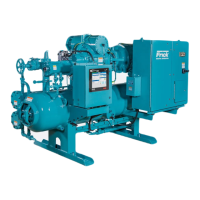RWF ROTARY SCREW COMPRESSOR UNITS
INSTALLATION
S70-600 IOM
Page 9
ECONOMIZER - HIGH STAGE (OPTIONAL)
The economizer option provides an increase in system ca-
pacity and efficiency by subcooling liquid from the condenser
through a heat exchanger or flash tank before it goes to the
evaporator. The subcooling is provided by flashing liquid in
the economizer cooler to an intermediate pressure level.The
intermediate pressure is provided by a port located part way
down the compression process on the screw compressor.
As the screw compressor unloads, the economizer port will
drop in pressure level, eventually being fully open to suc-
tion. Because of this, an output from the microprocessor is
generally used to turn off the supply of flashing liquid on a
shell and coil or DX economizer when the capacity falls be-
low approximately 45%-60% capacity (85%-90% slide valve
position). This is done because the compressor will be more
efficient operating at a higher slide valve position with the
economizer turned off, than it will at a low slide valve posi-
tion with the economizer turned on. Please note however
that shell and coil and DX economizers can be used at low
compressor capacities in cases where efficiency is not as
important as assuring that the liquid supply is subcooled. In
such cases, the economizer liquid solenoid can be left open
whenever the compressor is running.
Due to the tendency of the port pressure to fall with decreasing
compressor capacity, a back-pressure regulator valve (BPR)
is generally required on a flash economizer system (FIG. 8)
in order to maintain some preset pressure difference between
the subcooled liquid in the flash vessel and the evaporators.
If the back-pressure regulator valve is not used on a flash
economizer, it is possible that no pressure difference will ex-
ist to drive liquid from the flash vessel to the evaporators,
since the flash vessel pressure will approach suction pres-
sure at a decreased slide valve position. In cases where wide
swings in pressure are anticipated in the flash economizer
vessel, it may be necessary to add an outlet pressure regula-
tor to the flash vessel outlet to avoid overpressurizing the
economizer port, which could result in motor overload. Ex-
ample: A system feeding liquid to the flash vessel in batches.
The recommended economizer systems are shown below.
Notice that in all systems there should be a strainer (STR)
and a check valve (VCK) between the economizer vessel
and the economizer port on the compressor. The strainer
prevents dirt from passing into the compressor and the check
valve prevents oil from flowing from the compressor unit to
the economizer vessel during shutdown.
Other than the isolation valve
needed for strainer cleaning, it is
essential that the strainer be the
last device in the economizer line before the compres-
sor. Also, piston-type check valves are recommended
for installation in the economizer line, as opposed to disc-
type check valves. The latter are more prone to gas-
pulsation-induced failure. The isolation and check val-
ves and strainer should be located as closely as pos-
sible to the compressor, preferably within a few feet.
For refrigeration plants employing multiple compressors on a com-
mon economizing vessel, regardless of economizer type, each
compressor must have a back-pressure regulating valve in order
to balance the economizer load, or gas flow, between compres-
sors. The problem of balancing load becomes most important when
one or more compressors run at partial load, exposing the econo-
mizer port to suction pressure. In the case of a flash vessel, there
is no need for the redundancy of a back-pressure regulating valve
on the vessel and each of the multiple compressors. Omit the BPR
valve on the flash economizer vessel and use one on each com-
pressor, as shown in FIG. 9. It is also recommended that the back-
pressure regulating valves, used on economizer lines, should be
specified with electric shutoff option. The electric shutoff feature is
necessary to prevent flow from the common economizer vessel to
the suction side of a stopped compressor, through the suction
check valve bypass line, if the other compressors and the com-
mon economizer vessel are still operating and the HV2 valve on
the suction bypass is open.
For refrigeration plants using a Packaged Refrigerant Re-
circulation (PRR) unit and a direct expansion (DX) econo-
mizer system it is necessary to operate the liquid feed sole-
FIG. 7 - Direct Expansion Economizer System
FIG. 6 - Shell and Coil Economizer System
FIG. 9 -Multiple Compressor Economizer System
FIG. 8- Flash Economizer System
HIGH
PRESSURE
LIQUID
INTERMEDIATE PRESSURE
GAS TO COMPRESSOR
SUCTION
STR
VCK
SUBCOOLED
HIGH PRESSURE
LIQUID TO
EVAPORATOR
ECONOMIZER
COOLER
ECON1
HV-2
HIGH
PRESSURE
LIQUID
INTERMEDIATE PRESSURE
GAS TO COMPRESSOR
SUCTION
STR
VCK
SUBCOOLED
HIGH PRESSURE
LIQUID TO
EVAPORATOR
ECONOMIZER
COOLER
WIRING
ECON2
HV-2
HIGH
PRESSURE
LIQUID
INTERMEDIATE PRESSURE
GAS TO COMPRESSOR
SUCTION
STR
VCK
CONTROLLED
PRESSURE
SATURATED LIQUID
TO EVAPORATOR
ECONOMIZER
VESSEL
BPR
ECON3
HV-2
INTERMEDIATE PRESSURE
GAS TO COMPRESSOR
SUCTION
STR VCK BPR
CONTROLLED PRESSURE
SATURATED LIQUID TO EVAPORATOR
ECONOMIZER
VESSEL
ECON4
HV-2

